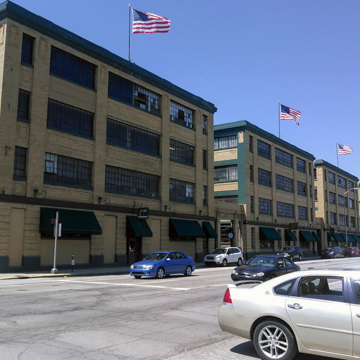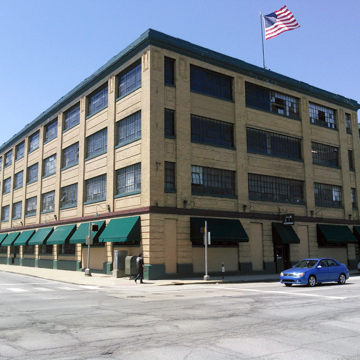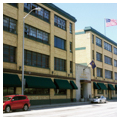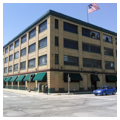You are here
Stutz Business Center
The automotive industry made perhaps the greatest impact on Indianapolis in the city’s development and growth in the early twentieth century. The creation of substantial automobile manufacturing facilities, including the Cole Motor Car Company and Stutz Motor Company, spurred the creation of related industries throughout the city, including the Wheeler-Schebler Carburetor Company, Prest-O-Lite Headlights Company, Allison Engine Company, and manufacturing plants for other automobiles, including Marmon, Dusenberg, and dozens of others. Moreover, the 1909 construction of the Indianapolis Motor Speedway provided manufacturers the ability to test and showcase their automobiles at sustained speeds prior to delivering them to customers.
In 1903, automotive entrepreneur Harry C. Stutz (1876–1935) moved to Indianapolis from Ohio and established the Stutz Auto Parts Company, manufacturing rear-axle–mounted transmissions. In 1911, Stutz’s Ideal Motor Car Company entered a car (built in five weeks) into the inaugural Indianapolis 500-Mile Race. The Stutz car took 11th place, earning it the moniker “The Car that Made Good in a Day.” The company continued to produce vehicles, including its most famous, the “Bearcat,” in 1912.
The success of Stutz’s automotive ventures led to the merger of his Ideal Motor Car Company and Auto Parts Company into the Stutz Motor Company in 1913. With the construction of a four-story factory complex, located on 10th Street across from the original building, the company ramped up production considerably, producing 2,207 automobiles by 1917. Stutz added a one-story garage and a showroom structure to the southwest corner of the block in 1917 and 1919, respectively. The Stutz Motor Car Company factory occupies an entire city block bounded by 10th and 11th streets and Senate and Capitol avenues. The complex comprises 400,000 square feet and includes the three-story original Ideal Motor Car Company building on the south side of 10th Street, five identical four-story factory buildings, the showroom, and the garage.
The buildings are constructed with a reinforced concrete frame and masonry infill exterior. The exteriors feature tan glazed brick with concrete sills, industrial metal-sash windows, rowlock window headers, continuous sheet metal cornices, and ornate terra-cotta medallions inscribed with the letter “S.” The garage and showroom structure on the southwest corner of the complex is more ornate, with a painted concrete base, terra-cotta sills, continuous terra-cotta cornice band and coping, additional terra-cotta monogrammed ornamentation, and shallow brick pediments at the corners and along the length of the building. The garage and showroom also feature saw-tooth roofs to maximize natural light within the spaces.
Harry Stutz sold his shares of the company to Charles Schwab in 1919, who subsequently took control of the company in 1922. The Stutz line saw its best years between 1926 and the early 1930s. However, the stock market crash in 1929 severely depressed the entire automotive industry, leading to the closure of the Stutz Motor Company in 1935 and formal dissolution of the company in 1937. In 1940, Indianapolis pharmaceutical giant Eli Lilly and Company purchased the Stutz factory and operated in the building until 1982. After sitting vacant for a decade, the property was purchased by Indianapolis commercial developer Turner Woodard in 1993 and was restored and adapted as a business center for small and mid-sized companies, currently serving more than 150 tenants.
References
Conant, Alan. “Stutz.” In Encyclopedia of Indianapolis.Edited by David J. Bodenhamer, David Gordon Vandestel. Bloomington: Indiana University Press, 1994.
Katzell, Raymond A. The Splendid Stutz: The Cars, Companies, People, and Races.Indianapolis: Stutz Club, Inc., 1996.
Monroe, Elizabeth Brand. “Built Environment.” In Encyclopedia of Indianapolis.Edited by David J. Bodenhamer, David Gordon Vandestel. Bloomington: Indiana University Press, 1994.
“The Stutz Building History.” The Stutz Indianapolis Business and Arts Center. Accessed April 16, 2018. http://www.thestutz.com/.
Writing Credits
If SAH Archipedia has been useful to you, please consider supporting it.
SAH Archipedia tells the story of the United States through its buildings, landscapes, and cities. This freely available resource empowers the public with authoritative knowledge that deepens their understanding and appreciation of the built environment. But the Society of Architectural Historians, which created SAH Archipedia with University of Virginia Press, needs your support to maintain the high-caliber research, writing, photography, cartography, editing, design, and programming that make SAH Archipedia a trusted online resource available to all who value the history of place, heritage tourism, and learning.



















